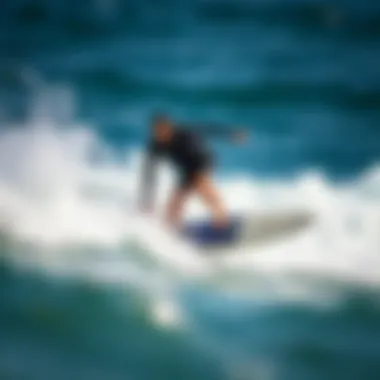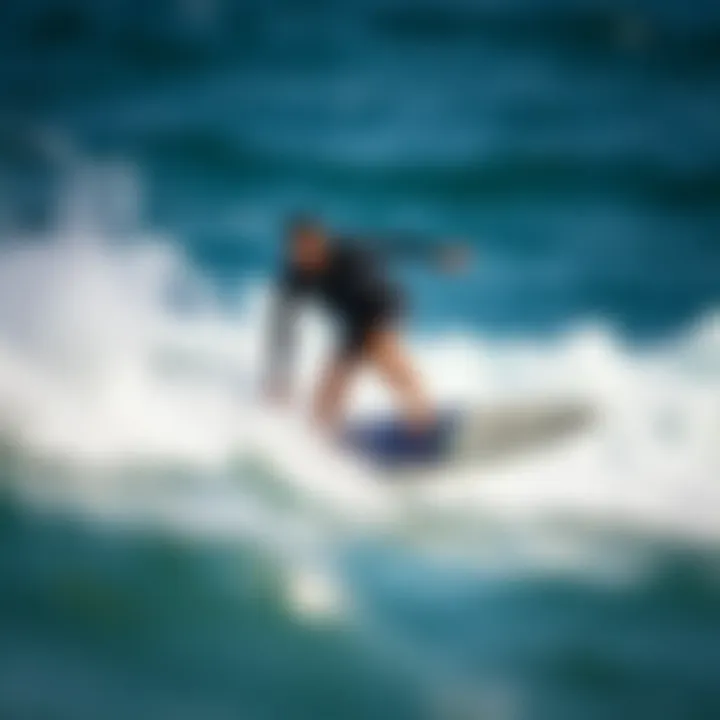The Evolution of Powered Surfboards: A Deep Dive


Intro
Powered surfboards are making waves—literally and figuratively. The marriage of cutting-edge technology with traditional surfing presents an invigorating avenue for enthusiasts who crave adventure. While full-throttle maneuvers once required natural waves, innovative propulsion has changed the landscape of wave riding. This section aims to delve deep into the thrilling realm of powered surfboards, oscillating between the classic techniques of surfing and the novel approaches that these modern machines offer.
Surfing Techniques
Beginner Tips for Getting Started
For those just dipping their toes into the world of powered surfing, it's important to differentiate between traditional techniques and the fluid art of powered riding. Ideal for novices or those looking to transition from regular surfing, here are some pointers:
- Balance is Key: Just like traditional surfing, mastering balance is paramount. Stand centered on your board, distributing your weight evenly. Feel the board's reaction under your feet and adjust accordingly.
- Use Your Core: Engage your core muscles to maintain stability. Much like a tightrope walker, using your core can help keep you upright, especially in choppy waters.
- Throttle Control: Powered surfboards come equipped with throttle controls, allowing you to manage speed. Start slow to feel comfortable before gradually sipping the adrenaline. Too much too soon could lead to wipeouts.
- Falling Safely: When you do fall—and you probably will—aim to roll off to one side instead of landing flat. This can decrease the impact on your body and board.
Advanced Maneuvers and Tricks
Once you've got the basics down, it’s time to play around with some advanced techniques to elevate your experience. Consider the following:
- Carving Turns: Utilize the thrust from your board to carve sharper turns. Lean into the turn while maintaining speed for a smooth transition.
- Jumping Waves: With a bit of practice, you can learn to ride up to a wave face and catch some air. The powered thrust makes this far more accessible than traditional surfing.
- Utilizing the Reverse Throttle: While this takes some finesse, quickly reducing speed can allow you to execute sudden stops or mellow transitions into different maneuvers.
- 360 Spins: Opt for a higher-speed setup and practice your spins. Maintain your balance as you rotate your body, allowing the momentum from the board to carry you around.
Surfboard Selection
Choosing the right powered surfboard can be as daunting as finding a needle in a haystack. Here are some essential considerations to keep in mind:
Choosing the Right Board for Your Style
Surfboards aren’t one-size-fits-all. Factors such as your weight, skill level, and preferred riding style play a crucial role in your selection:
- Motor Power: Higher motor power is often best for heavier surfers or those who desire top-notch speeds.
- Board Size: Longer boards often provide better stability, while shorter boards are better for agile maneuvers. Your personal preference shapes your decision.
- Material: Carbon fiber boards, though pricey, deliver superior performance and durability. If budget's tight, fiberglass might do the trick.
Surfboard Maintenance and Care
Taking care of your powered surfboard goes beyond just waxing the underside. Here are some practical tips:
- Regular Cleaning: Post-ride, rinse off saltwater and sand to prevent corrosion.
- Battery Management: Always monitor your battery level. Also, store it properly to extend its lifespan.
- Inspect for Damage: After every ride, check for any dings or popular signs of wear. This is vital to ensure both safety and performance.
Understanding Powered Surfboards
In a world where technology and outdoor sports are intertwining more than ever, powered surfboards are drawing considerable attention from enthusiasts and novices alike. They offer a compelling blend of traditional surfing and modern tech, but understanding the essence of these boards is crucial for anyone looking to ride the waves differently. This section digs into the definition, functionality, and components of powered surfboards, painting a clear picture of what makes them unique.
Definition and Functionality
Powered surfboards, often described as the next big thing in water sports, are essentially surfboards equipped with a propulsion system that allows riders to glide over water using electric power rather than relying solely on the ocean waves. These boards typically come with a battery-operated motor, enabling users to control their speed and direction.
This innovation has changed the surfing landscape considerably. For riders who may not have ideal wave conditions, powered surfboards are a game changer, making surfing accessible in flat water or smaller swells where traditional surfboards might fail. This integration of technology allows surfers to explore new areas, riding locations that were once thought to be limited to kayaking or stand-up paddleboarding.
Components of Powered Surfboards
To understand powered surfboards better, one must look at what makes them tick. From motor systems to battery technology, each component plays a significant role in their overall functionality.
Motor systems
The heart of a powered surfboard is its motor system. Typically, these boards utilize brushless motors, which are favored for their efficiency and longevity. The brushless design reduces wear and tear, making it a reliable choice for those who want to ride often in various conditions.
One of the key characteristics of these motors is their responsiveness. When a rider presses the throttle, the motor quickly responds, providing instant acceleration. This feature can be thrilling for users, allowing them to zip across the water. However, a downside can be the weight, as some motor systems can add significant bulk to the overall board, which may not appeal to everyone, especially those looking for a lightweight experience.
Battery technology
Battery technology is another decisive factor in the performance of powered surfboards. Lithium-ion batteries are the gold standard used in most models due to their high energy density and relatively low weight. This technology allows for longer ride times, which means surfers can spend more time on the water without the constant worry of running out of juice.
However, these batteries do come with pros and cons. On one hoof, their longevity is impressive, often providing anywhere from 30 to 90 minutes of riding time depending on factors like speed and terrain. On the other hand, they can be pricey, and users need to be aware of the lifecycle and eventual replacement costs.
Materials used
The materials used in the construction of powered surfboards greatly influence their performance and durability. Often, a combination of materials like epoxy resin and fiberglass is employed, which provides a sturdy yet lightweight structure. This mix ensures that the boards can handle the aquatic challenges without sacrificing maneuverability or speed.
Additionally, some brands are exploring eco-friendly materials and construction methods. The use of sustainably sourced materials presents an attractive option for environmentally-conscious surfers. However, these innovative materials may sometimes compromise on weight or flexibility, posing a dilemma for many when choosing the right board.
"Understanding powered surfboards requires a balance of mechanics, materials, and user experience to truly appreciate their impact on the surfing community."
In summary, comprehending the complexities of powered surfboards helps potential users make informed decisions. Each component interlaced with technology contributes to the evolving narrative of surfing, allowing enthusiasts to break traditional barriers and redefine what riding the waves means.
Historical Development of Surf Technology
The progression of surf technology tells a captivating story that reflects not just a change in equipment, but a transformation in the very culture of surfing itself. The historical development of surf technology is pivotal to understanding how powered surfboards have emerged as a novel blend of tradition and modernity. By examining this evolution, one can appreciate the significance of powered surfboards in enhancing surfing experiences while also noting their impact on enthusiasts and the marine environment.
Early Innovations in Surfing Equipment


Before the powered surfboard came to life, surfing was a purely manual sport relying heavily on a surfer's skill and the ocean’s natural waves. The earliest surfboards were carved from solid wood, reflecting the regional materials available. Early Hawaiian surfers used long wooden boards, some reaching lengths of 16 feet. These boards, often heavy and cumbersome, required considerable effort to maneuver through the water.
Each innovation was a response to the challenges faced by surfers. For instance, the introduction of lighter fiberglass boards in the 1950s marked a significant shift. This change made it easier for surfers to catch waves and perform tricks, paving the way for a more dynamic surfing culture. Aspects like board shape and fin design were experimented with, leading to the creation of various styles suited to specific types of waves. With the dawn of the 1970s, shortboards became popular, giving surfers increased control and maneuverability.
In summary, the early innovations in surfing equipment were driven by necessity and creativity. Each enhancement laid the groundwork for the next evolution in surf technology, culminating in the powered surfboards of today that promise not only speed but also accessibility.
The Rise of Powered Surfaces
The introduction of powered surfboards marks a significant milestone in surf technology, illustrating a shift in how surfers engage with the sport. These boards not only harness the power of electricity but also expand the surfing landscape beyond traditional wave-riding to enable a broader array of activities. With advancements in motor technology and battery performance, these boards offer speed and agility previously unseen in the sport.
The initial experiments with powered surfboards began in small garages, often constructed by passionate surfers looking to overcome restrictions imposed by natural conditions. Surfers began to realize that by integrating an electric motor, they could ride on calmer waters or even navigate without being dependent on wind or waves. The thrill of being propelled forward at exhilarating speeds redefined what surfers deemed possible.
Powered surfboards have become a tool that enhances the experience for both novices and experienced surfers. They allow those who might not have the skills or confidence to ride traditional waves an opportunity to engage with the ocean in a new way. Moreover, they have opened new avenues for professional surfers to showcase their talents in ways that align with competitive and recreational surfing.
In this era of advanced surf technology, the rise of powered surfaces has bridged the gap between tradition and innovation, attracting enthusiasts and professionals alike to explore the vast potential of surfing.
As we witness the evolution of powered surfing, it brings forth new challenges and considerations, especially relating to safety and environmental impact. Recognizing these aspects will be essential in ensuring that the sport evolves responsibly as it ushers in a new wave of surfing possibilities.
Benefits of Using Powered Surfboards
Powered surfboards are becoming increasingly popular among surfers, travelers, and outdoor enthusiasts. Their unique design and technology provide a range of benefits that traditional surfing methods cannot match. Whether you're a beginner or a seasoned surfer, understanding these advantages can enhance your overall riding experience and help you make informed choices about your equipment.
Enhanced Accessibility
One of the most significant benefits of powered surfboards is their ability to make surfing more accessible. Many individuals assume that surfing is only for those skilled enough to catch waves, but powered surfboards turn this notion on its head. With a motorized system, even those who might struggle in traditional surfing conditions can engage with the ocean in a meaningful way.
The ability to ride powered surfboards means that people with varying skill levels can join the fun. For instance, a person recovering from an injury may find it challenging to paddle out to the waves but can enjoy rides near the shore thanks to the surfboard's propulsion. Moreover, these boards allow enthusiasts to explore new locations that might not be feasible to visit without the aid of a consistent wave, breaking the barriers of accessibility.
Extended Riding Time
Powered surfboards elevate the experience with extended riding time. Traditional surfing often hinges on weather conditions, ocean currents, and tidal forces. These factors can dictate how long you can catch waves. Conversely, powered surfboards enable riders to venture further out and stay on the water for longer durations without exhausting themselves.
The battery technology incorporated into modern powered surfboards is quite sophisticated. For instance, some boards can provide up to 90 minutes of ride time on a full charge. This extended time frame allows enthusiasts to enjoy more consistent sessions without the typical fatigue associated with traditional paddling.
Additionally, having this extended riding time opens up opportunities for personal experimentation, skill development, and simply enjoying the ride without the pressure of constantly needing a wave to push off from.
Overcoming Wave Limitations
Another compelling advantage of powered surfboards is their ability to defy the limitations posed by the waves. Imagine being on a beach with a flat day and watching others surf, feeling left out. Powered surfboards allow users to ride the water even when the waves are not cooperating. They turn a potentially lackluster day into an adventure.
Riders can cruise across the surface of the water without the need for substantial waves, effectively transforming any body of water into a playground. The ability to control speed and direction with ease means enthusiasts can discover new spots and craft their own thrilling experiences at will.
In a nutshell, powered surfboards not only make surfing accessible to a greater array of individuals, but they also enhance the overall experience, placing less emphasis on favorable wave conditions and more on personal enjoyment. Whether you wish to enjoy leisurely rides or push the envelope of your surfing skills, these boards have something to offer.
"Powered surfboards are not just about speed; they are about redefining what is possible on the water."
In summary, the benefits of powered surfboards encompass enhanced accessibility, extended riding time, and the ability to overcome limitations imposed by traditional surfing environments. For those in the pursuit of wave-riding adventure, these innovations invariably improve the surfing experience, inviting a broader audience to relish the exhilaration of the ocean.
User Experience and Feedback
Understanding user experiences and feedback is paramount when discussing powered surfboards. These insights not only shape the evolution of surfboard technology but also influence how newcomers and seasoned surfers perceive these advancements. Feedback from users can reveal a multitude of factors, including performance, safety, and ease of use, all of which are essential in tailoring these surfboards to meet the needs of diverse enthusiasts. Furthermore, user experiences encapsulate the joy or frustrations felt while riding, thus providing a holistic view of the powered surfboard landscape.
Novices' Impressions
For newcomers to surfing, the world of powered surfboards can seem both exhilarating and overwhelming. Many novices report feelings of empowerment, as they are suddenly able to experience the thrill of surfing without being at the mercy of nature’s waves. A powered surfboard offers a sense of autonomy that traditional surfing may not provide.
Often, beginners express a mix of awe and trepidation during their first rides. Typical feedback includes:
- Ease of Learning: Many novices find that the gentle push of the motor helps them stay afloat longer and gain confidence quickly.
- Accessibility: Accessibility becomes a key factor, as individuals who may have shied away from surfing due to physical limitations can participate more fully.
- Support Community: New riders often remark on the community aspect. Many find support in local groups on platforms like Facebook and Reddit, where experienced riders share tips and advice.
"I thought I'd wipe out a lot, but the powered surfboard just kept me gliding. It felt amazing to ride so smoothly!" — A first-time powered surfer.
Expert Surfer Insights
For expert surfers, the powered board is both a tool and a topic of debate. Seasoned riders approach powered surfboards with specific expectations about performance and agility. Their feedback typically dives into deeper analyses regarding
- Performance Comparison: Experts frequently compare powered surfboards to their traditional counterparts, with many indicating that while powered boards can enhance the riding experience through speed, they often compromise some agility found in wave-riding.
- Skill Enhancement: There are insights about how these surfboards can aid in training, offering professional riders a chance to practice maneuvers without the need to wait for perfect waves.
- Cultural Shift: From a cultural perspective, some experts express concerns about the potential alteration in the sport’s essence. Many worry that the thrill of riding natural waves may fade if such conveniences become the norm.
A typical sentiment shared among experts includes:
- Versatility in Different Conditions: Many surf professionals appreciate how powered surfboards allow them to navigate various conditions, opening new spots that might be challenging without a powered advantage.
- Rider Control: Experts emphasize the need for familiarization with the control mechanisms. Many insist that mastering the nuances of acceleration and braking is crucial for safety and fluid riding.
Experiences like these highlight the diverse perspectives within the surf community, as both novices and experts contribute to the evolving conversation around powered surfboards. This dialogue is vital, shaping future innovations and enhancing user satisfaction, ultimately defining how these surfboards can bridge the gap between tradition and modern surf technology.
Choosing the Right Powered Surfboard
Selecting the right powered surfboard transcends mere preference; it involves understanding one's sailing needs, riding style, and environmental impact. Given the myriad of options available, each characterized by distinct specifications and functionalities, it's crucial to identify which board aligns best with personal aspirations and surfing context. This section delves into the fundamental elements that should guide your decision-making process, illuminating the benefits and considerations that accompany the selection of powered surfboards.


Key Specifications to Consider
Weight and portability
When it comes to powered surfboards, weight and portability can make or break your experience. A lighter board not only ensures ease of transport but also enhances maneuverability in the water. For example, a board that weighs around 30 pounds may seem hefty if you're planning to carry it on long treks to remote beaches or secluded lakes. However, many manufacturers have started using advanced materials, such as carbon fiber and polyethylene, to produce lightweight yet durable models.
This characteristic can determine your ability to paddle back to shore after a thrilling ride. Heavier boards, while sometimes offering more stability in the water, can be cumbersome for beginners or casual surfers. Choose wisely; you want to enjoy the freedom to ride the waves rather than lugging around a burden.
Battery life
Battery life, potentially the crux of your powered surfboarding experience, influences how long you can paddle before needing a recharge. A decent battery can provide anywhere from 30 minutes to an hour of riding time. For those who thrive on longer waves, opting for boards equipped with higher capacity batteries is vital.
Some models utilize lithium-ion technology, which promises not only longevity but also faster recharge times. However, keep in mind that a powerful battery often adds to the overall weight of the board. Consider your style of surfing—if you plan on multiple consecutive rides, investing in a board with outstanding battery life may just be worth it.
Speed capabilities
Speed can be a thrilling detail in the realm of powered surfboards. The range of speed capabilities available can vary widely, from boarding speeds suitable for leisurely gliding to powerful bursts that can rival conventional surfing speeds. Fast boards can be ideal for experienced surfers looking to pull off maneuvers or ride against strong currents.
However, one must recognize that speed is not always synonymous with control. Ensuring that the board’s design aligns with your skill level is paramount when considering speed capabilities. Higher speed models may require refined handling skills—choosing a balanced board suited to your experience ensures that you won't bite off more than you can chew.
Popular Brands and Models
The market boasts a range of reputable brands recognized for their quality and innovation. Notable ones include:
- Lift Foils - Known for cutting-edge technology and performance-enhancing features.
- Radinn - Offers customizable powered boards with impressive speed and range.
- Awake - Focuses on electric surfboards with high-speed potential and design ergonomics.
When looking at specific models, it’s helpful to compare user reviews, focusing on factors like durability and user-friendliness. Each of these brands brings something unique to the table, catering to different surfing styles, preferences, and budgets, so exploring their offerings can aid in identifying the perfect fit.
In the vast landscape of powered surfboards, making an informed choice is critical. By considering elements like weight, battery life, speed, and brand reputation, surfers can find a board that harmonizes with their riding ambitions and enables exhilarating experiences.
Environmental Considerations
The swift rise of powered surfboards has not only transformed how enthusiasts experience surfing but also brought forth important discussions about environmental impacts. As we navigate through this new wave of innovation, it’s vital to analyze how these powered devices influence ocean ecosystems, and what alternatives exist to mitigate damage. Some may say that progress comes with a price, but understanding this cost will enable riders to make informed choices.
Impact on Ocean Ecosystems
When we talk about the interaction between powered surfboards and ocean ecosystems, we can’t just brush aside the potential consequences. The sound pollution created by electric motors can disturb marine life, particularly sensitive species like dolphins and sea turtles, which rely on sound for communication and navigation. In some environments, such as coral reefs, the impact goes beyond noise. Turbulence from these boards can lead to sediment disruption, affecting the delicate balance of these ecosystems.
Moreover, the human activity associated with powered surfboarding, such as increased foot traffic on shores and potential damage to natural habitats, could result in long-term ecological implications. It’s crucial for users to be both aware and conscious of where and how they are riding. For instance, choosing spots that are less biodiverse may lessen the adverse impact on fragile ecosystems.
"Each powered board ripples through the sea, and it is our responsibility to ensure those ripples do not drown our reefs."
Eco-Friendly Alternatives
There is a burgeoning movement toward developing environmentally friendly options for powered surfboards. Manufacturers are increasingly aiming to create boards that not only deliver performance but also prioritize ecological sustainability. Here are some exciting developments to keep an eye on:
- Solar-Powered Models: Some companies are experimenting with solar panels integrated into the body of the surfboard, which harvest energy from sunlight to power the motor. This reduces dependence on traditional batteries, making the surf experience more sustainable.
- Biodegradable Materials: Instead of conventional plastics, manufacturers are exploring materials that decompose naturally. Using biodegradable compounds helps reduce the ecological footprint of surfboards, even after their life cycle ends.
- Electric Motors with Lower Noise Levels: Innovations in motor technology have led to the creation of quieter engines. These motors not only benefit users seeking a more serene experience but also lessen the disruption to marine animal communication.
- Community Programs for Sustainability: Several surf communities are taking it upon themselves to host beach cleanups and programs focused on educating users about environmental friendliness. Engaging with local efforts fosters a sense of responsibility among surfers.
By choosing eco-friendly options, surfers not only enjoy the thrill of powered riding but also contribute positively to marine conservation. As innovation continues, the hope is to enhance that balance between enjoyment and sustainability.
The Role of Powered Surfboards in Surf Culture
As the tides of the surfing world shift, powered surfboards are making waves, shaping the culture in ways we never expected. The integration of technology into this traditional sport raises important questions about identity, accessibility, and the future of riding the waves. It transcends mere equipment; it's about embracing innovation while respecting legacy. How do these modern boards sit alongside traditional surfing practices, and what influence do they hold over the community's dynamics? Let's explore.
Integration into Traditional Surfing
The roots of surfing run deep, entangled in oceanic traditions that span centuries. But now, as powered surfboards carve out their niche, we're witnessing an interesting blend of the old and new.
These boards have not replaced traditional surfing; rather, they've expanded the horizons. Many surfers find the experience exhilarating, using them to explore out-of-reach waves or enhancing their sessions without relying solely on favorable winds or waves. For instance, consider how powered surfboards allow users to surf in less-than-ideal conditions—where once, surfers would sit and wait, now they can glide across flat waters, enriching their experience.
In local surf communities, powered boards are becoming a common sight on the beaches. Some surfers embrace this change, seeing it as an opportunity to introduce a wider audience to the joys of riding the waves—allowing newcomers to participate without the steep learning curve that traditional surfing often entails. Yet, this adoption comes with its own set of tensions, as long-standing surfers sometimes view powered boards as detracting from the purity of the sport.
Ultimately, this integration speaks volumes about adaptability. Surf culture has always evolved, reflecting the various influences that come crashing in with each new swell. Today, we see this reflected in the welcoming arms of powered surfboards, as they challenge both riders and enthusiasts to reconsider what surfing truly means.
Shift in Community Perceptions
With the rise of powered surfboards, there has been a noticeable shift in how communities perceive surfing. No longer is it an exclusive domain for those who can navigate the waves with pure physics and muscle. Instead, powered boards represent inclusivity—offering a way for individuals of varying skill levels to partake in the ocean sports community.
This has led to some differing viewpoints among surfers. On one hand, there are those who celebrate the democratization of the sport, appreciating how these boards allow people who might have been excluded due to physical limitations to participate. Surfers with mobility challenges or those who simply want a different riding experience can find joy in powered boards, making the sport accessible to many.
On the other hand, purists voice concerns over the potential fragmentation of surfing culture. They argue that with convenience comes a loss of skill-based connection to the sport; this fear often manifests in heated discussions in local surf shops or online forums. The dialectic between tradition and innovation underscores how powered surfboards are reshaping perceptions, pushing the community to grapple with its evolving identity.
In a nutshell, these boards act as a mirror reflecting the diverse landscapes of thought and experience within the surf culture. It’s important to keep the conversation going, to ensure that all voices are heard as this sport navigates its wavy future.
“Whenever there's an innovation, there's bound to be debate. The key is to appreciate diverse perspectives while staying true to the essence of the sport.”
As the surf scene evolves, powered surfboards carve their path, engaging more and more individuals. With each swell, their influence on culture unfolds, shaping how future generations connect with the ocean and each other.


Future Trends in Surfboarding
The world of surfing is constantly riding the waves of innovation. As powered surfboards gain traction among enthusiasts, exploring future trends in surfboarding offers valuable insights into where the sport is headed. Understanding these trends not only highlights upcoming advancements but also showcases how they might enhance the overall surfing experience. The trends can bring about remarkable benefits, such as improved performance, accessibility, and sustainability, all while maintaining the thrill of gliding over water. This section dives into the essentials that every surfer should consider.
Technological Advancements on the Horizon
As technology continues to evolve, powered surfboards are at the forefront of exciting developments. One aspect that stands out is the integration of advanced motor technology and improved battery systems. The push for lighter and more efficient motors is crucial because it affects the speed and agility of the board. Innovations in battery technology, especially lithium-ion and emerging solid-state batteries, promise longer ride times and quicker recharge cycles, which could redefine user experiences.
- Lightweight Materials: The use of carbon fiber and other composite materials will reduce weight without compromising strength. This shift is essential for enhancing maneuverability.
- Smart Features: Expect to see surfboards equipped with smart technology that tracks performance metrics like speed, distance, and riding style. These features can help users adjust their technique for optimal performance.
- Sustainability Innovations: The industry is also turning its eyes toward eco-friendly materials and energy-efficient designs. This trend reflects a growing consciousness about environmental impact, appealing to a conscientious clientele.
"The next wave of surfboard technology is not just about speed but also about knowing the ocean and yourself better."
The Potential of Autonomous Surfboards
Autonomous surfing technology might seem like a distant dream, but its potential is becoming more tangible. Picture a surfboard that adjusts its speed and direction based on wave conditions or user preferences, providing an unparalleled riding experience. This concept opens doors to numerous possibilities. Think about adaptive learning algorithms that allow surfers to personalize settings based on their skill level and conditions.
- AI Navigation: Incorporating AI means that your surfboard could learn your preferred riding style and optimize its performance accordingly.
- Safety Features: Advanced sensors could reduce risks by automatically adjusting speed during challenging conditions, thus providing an extra layer of security to riders.
- Competitive Edge: For professional surfers, the data collected through autonomous boards can help refine techniques and strategies, potentially giving them a competitive edge in competitions.
As we look ahead, powered surfboards are more than just a passing trend; they're a glimpse into a new horizon for surfing, marrying technology with tradition. By understanding and adapting to these trends, surfers can ensure they stay not only on top of personal waves but at the forefront of a rapidly evolving sport.
Expert Tips for Maximizing the Powered Surfboard Experience
When venturing into the realm of powered surfboards, it’s not just about getting on the water and making waves. Success in utilizing these cutting-edge machines hinges on mastering specific techniques and maintaining the equipment diligently. This section highlights expert tips that will enhance your surfing experience, helping you to navigate through the thrill with ease and confidence.
Riding Techniques to Master
Body Positioning
Body positioning is crucial when riding a powered surfboard. The right stance allows for better control and balance, ultimately contributing to an improved overall experience on the water. For instance, maintaining a slightly bent knee stance lowers your center of gravity, giving you more stability against the board’s thrust.
Key Characteristic: This positioning helps absorb the board's movements caused by waves or speed changes.
Advantage: Not only does it provide stability, but it also enhances your ability to shift weight for turns and acceleration. By keeping your body balanced over the board, you can minimize the risk of wiping out.
However, be mindful of leaning too far forward or backward, as this can lead to loss of control and, eventually, a tumble into the water. Mastering body positioning can significantly transform a beginner’s experience into something truly exhilarating.
Control Mechanisms
Control mechanisms on powered surfboards can make or break your ride. Understanding the nuances of throttle control and steering adjustments is key to staying upright and making those sharp cuts in the water. When you grip the throttle, it’s important to apply pressure gradually; sudden bursts can lead to instability and off-balance moments.
Key Characteristic: Most powered surfboards use a handheld remote to manage speed, putting you in full command.
Advantage: This design allows for precision in acceleration, giving you the ability to adjust your speed easily according to conditions. Furthermore, maneuvering sensitivity can also vary based on the board’s design.
For instance, some boards may have a more responsive steering, while others are designed for a smoother cruise. Familiarize yourself with your specific board’s controls for a tailored riding experience. Good control mechanisms can lead to a significantly more enjoyable ride, making the difference between a fantastic experience and an arduous struggle.
Maintenance Essentials
With great power comes great responsibility, especially when it comes to maintenance. Regular upkeep of your powered surfboard ensures longevity and peak performance. Here are some essential maintenance tips:
- Battery Care: Always check battery levels before heading out. Discharge and recharge cycles should be adhered to according to the manufacturer’s guidelines to prolong the life of the battery.
- Regular Cleanings: Rinse off saltwater and debris after every ride to prevent corrosion and wear. This is especially crucial for marine equipment.
- Inspect Components: Regularly inspect the motor and propeller for damages or wear. Early detection can prevent more significant issues down the line.
- Follow Manufacturer Guidelines: Always refer to the provided manual for specific maintenance recommendations. It’s tailored for your model to optimize its performance and durability.
Remember, a well-maintained powered surfboard isn’t just about extending its lifespan; it also enhances your surfing experience, making every ride smoother and more enjoyable.
"Treat your powered surfboard like a relationship. It needs attention, care, and a bit of love to perform its best on the waves."
By honing specific riding techniques and committing to essential maintenance, enthusiasts can dramatically enhance their powered surfboarding journey, ensuring a thrilling and fulfilling experience on the water.
Navigating Local Laws and Regulations
Navigating the realm of powered surfboards requires an understanding of diverse local laws and regulations. As these boards gain traction, authorities are stepping up their oversight to ensure participant safety and environmental conservation. Being well-versed in this landscape helps enthusiasts avoid pitfalls, keep their activities lawful, and enhance their overall surfing experience.
Legal Considerations for Powered Surfboards
When considering the legality of powered surfboards, numerous aspects need attention. Different regions may enforce varying rules that dictate where these surfboards can be utilized. Because powered surfboards are motorized, they often fall under the same regulations as watercraft. Users should be familiar with the following;
- Registration Requirements: Many places require powered surfboards to be registered, similar to traditional boats. This might involve providing proof of ownership and ensuring safety standards are met.
- Licensing: Some jurisdictions may demand operators possess a specific boating license or certificate demonstrating their competency in handling motorized aquatic equipment.
- Speed Limits: Authorities often impose speed limits to maintain safety on the waters. Riders should explore these restrictions to operate within legal bounds, preventing fines or accidents.
- Designated Areas: There may be specific zones where powered surfboards are allowed or prohibited. Riders who ignore these parameters could face legal consequences.
Understanding your local regulations helps avoid unnecessary fines while promoting a safer surfing culture.
Permits and Safety Guidelines
Apart from legal considerations, obtaining the necessary permits is vital. Often, this involves applications and fees to the relevant local authorities before one can even take a powered surfboard out on the water.
Moreover, aspiring riders should dive into safety guidelines to protect themselves and others:
- Personal Flotation Devices (PFDs): Many regulations mandate the wearing of life jackets while riding powered surfboards. This precaution can save lives in case of mishaps.
- Environmentally Sensitive Areas: Some regions may restrict the use of powered surfboards in wildlife sanctuaries or marine protected areas. Riders should be informed about these zones to avoid accidental infringements or harm to local ecosystems.
- Age Restrictions: Depending on the location, age limits may apply. Minors, for example, might need adult supervision or permission before they can ride.
In summary, understanding the legal landscape surrounding powered surfboards not only respects the community and environment but also sets the stage for enjoyable rides. By being informed and compliant, surfers can navigate the waters with confidence and pleasure.
"Stay savvy, ride safely! Knowing the rules is part of being a responsible surfboarder and ensures that everyone can enjoy the waves together."
For more information on local regulations and safety guidelines for powered surfboards, check resources like NOAA, ASL, or your local government’s aquatic regulations.



